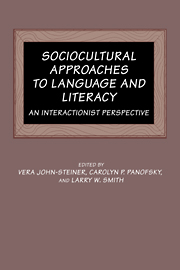Book contents
- Frontmatter
- Contents
- List of contributors
- 1 Introduction
- Part 1 Context
- Part II Mediational processes
- 5 Nonverbal factors in the interpsychic to intrapsychic internalization of objects
- 6 An ecological approach to the emergence of the lexicon: Socializing attention
- 7 Learning how to explain: The effects of mother's language on the child
- 8 Developing the representational functions of language: The role of parent–child book-reading activity
- 9 The implications of Vygotskian theory for the development of home-school programs: A focus on storybook reading
- 10 Vygotsky in the classroom: An interactionist literacy framework in mathematics
- Part III Functional systems
- Author index
- Subject index
5 - Nonverbal factors in the interpsychic to intrapsychic internalization of objects
Published online by Cambridge University Press: 05 November 2011
- Frontmatter
- Contents
- List of contributors
- 1 Introduction
- Part 1 Context
- Part II Mediational processes
- 5 Nonverbal factors in the interpsychic to intrapsychic internalization of objects
- 6 An ecological approach to the emergence of the lexicon: Socializing attention
- 7 Learning how to explain: The effects of mother's language on the child
- 8 Developing the representational functions of language: The role of parent–child book-reading activity
- 9 The implications of Vygotskian theory for the development of home-school programs: A focus on storybook reading
- 10 Vygotsky in the classroom: An interactionist literacy framework in mathematics
- Part III Functional systems
- Author index
- Subject index
Summary
As is well known, Vygotsky (1962, 1978,1981) argued that new achievements appear in children's mental (or cultural) development twice: first interpsychically, as part of the social interaction of the child with adults or older children, later intrapsychically, as part of the child's own internal mental operations. In this way, the child is presented with and finally internalizes cultural knowledge, and this knowledge becomes part of the child's own way of thinking. It is the hypothesis of this paper that the adult's gestures during social interactions with children are an essential part of the communication and thus of the guidance that adults provide, and that the child's gestures are a crucial source of feedback for the adult. Depending on the gestural component, completely different communicative situations can develop, success or failure can occur, and the child's willingness to learn may be strengthened or weakened. All of these processes can be observed going on during adult–child interactions. Adult's gestures embody and thus display a host of assumptions about both the social and physical world – how complexity in objects “naturally” breaks apart, what is a “natural” chunk of information (such that it is believed to be processible by the child), what an “action” is and what types there are, what counts as “attention”; and “understanding,” and what one's approach to objects ought to be, and thus what their meaning is. Adult's assumptions in these spheres are made manifest unwittingly in the gestures and other nonverbal behavior directed to children.
- Type
- Chapter
- Information
- Sociocultural Approaches to Language and LiteracyAn Interactionist Perspective, pp. 147 - 169Publisher: Cambridge University PressPrint publication year: 1994
- 1
- Cited by

